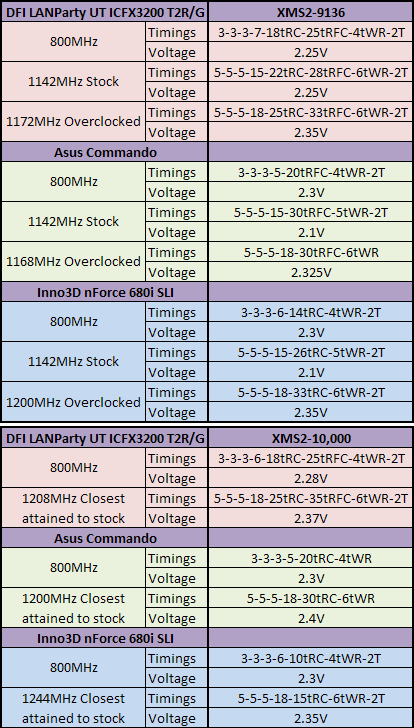Test Setup
Intel Core 2 Extreme X6800; Inno3D nForce 680i SLI, Asus Commando, DFI LANParty UT ICFX3200-T2R/G, Nvidia GeForce 7900 GT; Seagate Barracuda 7200.9 200GB SATA 3Gbps hard disk drive; OCZ GameXStream 700W power supply unit; Windows XP Professional Service Pack 2; DirectX 9.0c; Nvidia Forceware 93.71 WHQL.We tested the memory in each of the three different types of Intel motherboards to give a taste of what they are each capable of. The Corsair memory uses EPP which is specifically tailored towards the nForce 680i SLI chipset of the Inno3D motherboard, but we also found to some extent the DFI and Asus boards also read and set the enhanced memory timings.
The tests included running (or trying to run) at the rated speed, the tightest latencies we could set stably at DDR2-800, and finally the maximum attainable overclock if there was additional headroom left in the boards and / or the memory modules. In addition to a selection of real-world test scenarios, we ran SiSoft Sandra synthetic benchmarks for a raw reference reading.
The three motherboards work differently; from the limited memory ratios on the Asus Commando with its Intel P965 chipset to the fully independent memory controller on the DFI LANParty UT ICFX3200-T2R/G. Since memory bandwidth is somewhat dependent on CPU speed, this meant we tried to work around board limitations and match the CPU speed to the stock value of 2933MHz as close as possible in order to provide comparative results.

Despite some boots with a memory setting of 2 in either CAS Latency, RAS to CAS Delay or RAS Precharge Delay never was it stable. The Row Active Delay could however be reduced below the usual 9 to as low as 5/6 in some cases, depending on the motherboard. Only the Inno3D nForce 680i SLI offers true EPP and clocks the closest to the native 1250MHz as possible with the XMS2-10000. The next ratio available provided 1280MHz on the memory, and despite it being capable of booting at this speed it was unstable. It was quite disappointing to be board limited in all cases, even though we are dealing with some of the most advanced and overclockable consumer motherboards available.
The Inno3D nForce 680i SLI also overclocked the XMS2-9136 to 1200MHz, over and above the DFI LANParty UT ICFX3200 T2R/G and Asus Commando. We found we could go a lot lower with the timings and remain stable with 2T than 1T on all the motherboards.
The DFI couldn’t run the XMS2-9136 at stock speeds with the nominal 2.1V that the memory is rated for; we had to increase the voltage to 2.25V in order to get it stable. On both the Inno3D and Asus 2.1V was more than enough to keep it stable, and the Write Recovery time (tWR) was also reduced in both cases.

MSI MPG Velox 100R Chassis Review
October 14 2021 | 15:04









Want to comment? Please log in.